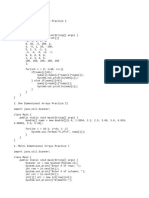0% found this document useful (0 votes)
34 views20 pagesSAT Practice Questions
The document contains a series of programming problems and their solutions, categorized into easy, medium, and difficult levels. Each problem includes input and output formats, constraints, and sample inputs and outputs. The problems cover topics such as patterns, Fibonacci numbers, sums and products, array manipulation, and matrix operations.
Uploaded by
impraticaluse99Copyright
© © All Rights Reserved
We take content rights seriously. If you suspect this is your content, claim it here.
Available Formats
Download as PDF, TXT or read online on Scribd
0% found this document useful (0 votes)
34 views20 pagesSAT Practice Questions
The document contains a series of programming problems and their solutions, categorized into easy, medium, and difficult levels. Each problem includes input and output formats, constraints, and sample inputs and outputs. The problems cover topics such as patterns, Fibonacci numbers, sums and products, array manipulation, and matrix operations.
Uploaded by
impraticaluse99Copyright
© © All Rights Reserved
We take content rights seriously. If you suspect this is your content, claim it here.
Available Formats
Download as PDF, TXT or read online on Scribd
/ 20




















































































